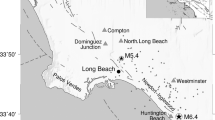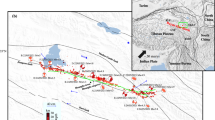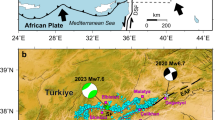Abstract
In May 1985 we predicted1 that an earthquake would occur on the San Andreas fault near Stone Canyon, California within a year. The prediction was based on the observation of seismic quiescence–defined as a significant decrease in the average occurrence rate of earthquakes within the source volume of the future mainshock. A mainshock of magnitude ML = 4.6 occurred on 31 May 1986, rupturing exactly the specified segment of the fault. This is the first successful prediction of an earthquake along the San Andreas fault, and the probability to have come true by chance is <5%. Although the prediction addressed only a small main-shock, its success was significant because the location, size and occurrence time were correctly specified for an earthquake in a populated area. Larger earthquakes will undoubtedly be successfully predicted by the same method in the future, but the major segments of the San Andreas fault near San Francisco and Los Angeles have such a low-background seismicity rate that the method will probably not be applicable there.
This is a preview of subscription content, access via your institution
Access options
Subscribe to this journal
Receive 51 print issues and online access
$199.00 per year
only $3.90 per issue
Buy this article
- Purchase on Springer Link
- Instant access to full article PDF
Prices may be subject to local taxes which are calculated during checkout
Similar content being viewed by others
References
Wyss, M. & Burford, R. O. US Geol. Surv. open file report, 85–745, 376–426 (1985).
Mogi, K. Bull. Earthq. Res. Inst. Tokyo, Univ. 47, 395–417 (1969).
Ohtake, M., Matumoto, T. & Latham, G. V. Pure appl. Geophys. 115, 375–386 (1977).
Wyss, M. Earthq. Predict. Res. 3, 519–543 (1985).
Wyss, M. & Habermann, R. E. US Geol. Surv. open file report (1986).
Kisslinger, C., McDonald, C. & Bowman, J. R. Proc. IASPEI General Assembly, Tokyo, 32, (1985).
Bakun, W. H. & Lindh, A. G. Science 229, 619–624 (1985).
Wyss, M. Bull. seism. Soc. Am. 76, 785–800 (1986).
Wyss, M. & Habermann, R. E. US Geological Survey open file report (1986).
Habermann, R. E. Bull. seism. Soc. Am. 72, 93–112 (1982); J. geophys. Res. 88, 5056–5064 (1983).
Habermann, R. E. Bull. seism. Soc. Am. 76, 1660–1667 (1986).
Reasenberg, P. J. geophys. Res. 90, 5479–5495 (1985).
Wyss, M., Klein, F. W. & Johnston, A. C. J. geophys. Res. 86, 3881–3900 (1981).
Haberman, R. E. Earthquake Prediction, Maurice Ewing Series Vol. 4, 29–42 (American Geophysics Union, Washington, DC, 1981).
Wyss, M., Habermann, R. E. & Griesser, J. C. J. geophys. Res. 89, 9293–9304 (1984).
Burford, R. O., Schulz, S. S. US Geol. Surv. open file report, 85–754, 294–315 (1985).
Author information
Authors and Affiliations
Rights and permissions
About this article
Cite this article
Wyss, M., Burford, R. Occurrence of a predicted earthquake on the San Andreas fault. Nature 329, 323–325 (1987). https://doi.org/10.1038/329323a0
Received:
Accepted:
Issue Date:
DOI: https://doi.org/10.1038/329323a0
This article is cited by
-
Detection of seismic quiescences before 1991 Uttarkashi (Mw 6.8) and 1999 Chamoli Mw (6.6) earthquakes and its implications for stress change sensor
Acta Geophysica (2022)
-
Earthquake hazard potential in the Eastern Anatolian Region of Turkey: seismotectonic b and Dc-values and precursory quiescence Z-value
Frontiers of Earth Science (2018)
-
Statistical monitoring of aftershock sequences: a case study of the 2015 Mw7.8 Gorkha, Nepal, earthquake
Earth, Planets and Space (2016)
-
Seismic quiescence precursors to two M7 earthquakes on Sakhalin Island, measured by two methods
Earth, Planets and Space (2014)
-
Anomalies of Seismic Activity and Transient Crustal Deformations Preceding the 2005 M 7.0 Earthquake West of Fukuoka
Pure and Applied Geophysics (2010)
Comments
By submitting a comment you agree to abide by our Terms and Community Guidelines. If you find something abusive or that does not comply with our terms or guidelines please flag it as inappropriate.



